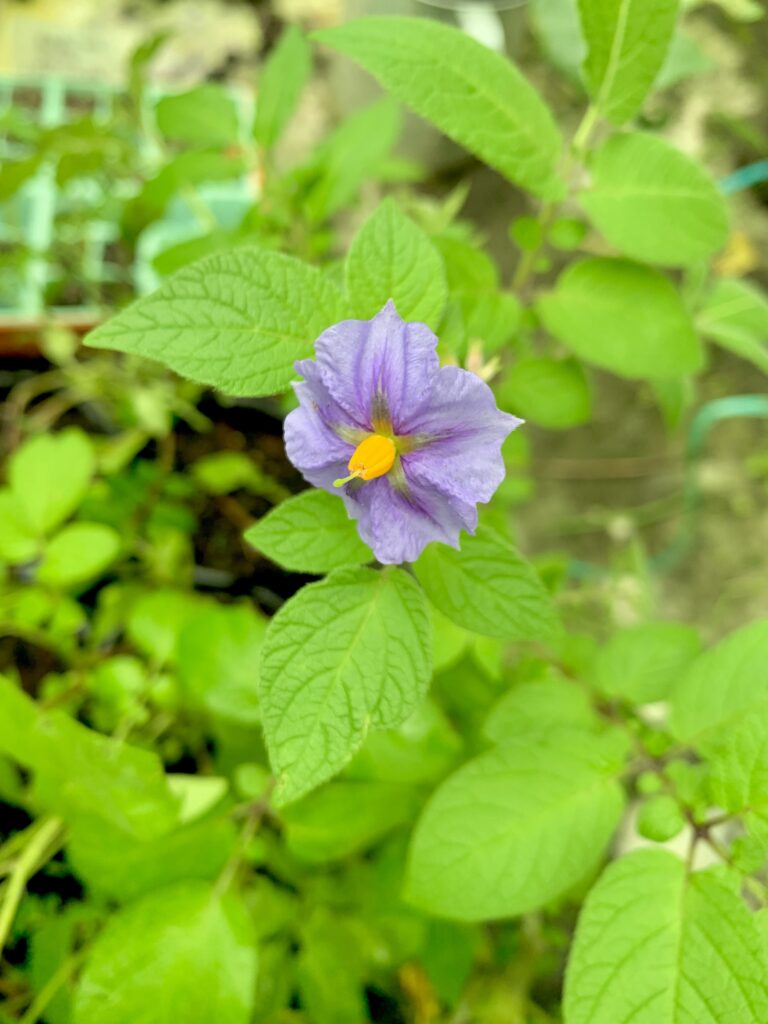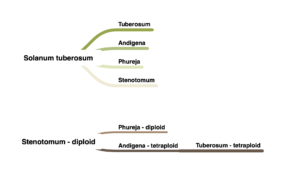True Potato Seed – TPS
Crossing and growing potatoes from seed is a challenge but an interesting project.
Perennial plant that is usually regrown from tubers.
Perfect flowers with multiple methods of pollination – wind, insect and self. In this case manual.
Flowers can be covered with isolation mesh bags once pollinated.
Seeds are very small and very slow to germinate and grow initially. Can be grown and small pits or trays. Seedlings grow much faster once established past true leaf.
Usually two groups of varieties – long and short dormancy. Short dormancy tubers will often resprout within weeks or even days of being harvested.
Seeds can be harvested from berries when they turn slightly darker, get slightly softer or start to drop to the ground.
Maceration of berries and washing the seed for drying is the usual harvesting method.
Seeds will last for a very long time if prepared well and dried to 5% moisture level. Up to at least 15 years.

Background description
Potatoes primarily come from the South and Central Americas – Peruvian and Bolivian Andes highlands – but have been cultivated and moved around by humans for many thousands of years.
True Potato Seed is the actual seed of the potato that is obtained by letting flowers cross pollinate and develop fruit or berries and then collecting the seed from those berries to grow on.
This is true sexual reproduction as opposed to using selected ‘Seed’ potatoes.
Seed potatoes that you see most commonly sold are actually simply just selected tubers from commercially grown varieties. These have been carefully grown to exclude as many problems like diseases as possible. Growing on those tubers to let them form plants basically is a ‘clone’ or division of the original.
There are many species of potato but the main edible potatoes we grow are mainly from the one main species Solanum tuberosum that is then broken up into four groups. These groups used to be separate named species but recent genetic testing has confirmed that they are all sub groups of the same species.

Commonly grown Potatoes (Solanum tuberosum) are quite a complex genetic mix and have two main forms – Diploid with two sets of chromosomes and Tetraploid with 4 sets of chromosomes that are basically a doubling of the original Diploid species.
All potatoes that you can get to eat and grow have at some stage been bred and grown from seed.
However these complex genetics mean that some have lost the ability to form pollen, accept pollen or even flower reliably. In some varieties the anthers have fused and can not open to allow pollen to get to the stigma and pollinate the flower. In some the pollen is malformed and not viable and so the variety can only accept pollen but not pollinate other plants.
You can sometimes get berries forming in your garden on some common potato varieties. Pink fir Apple is an example.
Potatoes in Europe were primarily grown for their flowering as decorative plants for a long time by some nations. Potatoes were considered inedible and undesirable as food by many when they are first brought to Europe from the Americas.
As the eating of potatoes became more acceptable and even promoted by some governments as reliable food, growing them from seed became common place and was a regular feature of kitchen gardening. However the ease and reliability of growing them from tubers eventually became the dominant way to grow them.
In 2022 growing them from seed is now returning as a mass farming technique in some places due to issues of having to save a large component of your crop to regrow each year align with the transport costs of moving large sacks of stored potato tubers around – to and from growing and storage areas.
There are many other species that are closely related that have been and still are grown for food.
Seeds tend to have less issues with diseases and create new forms and varieties including unusual colours and characteristics such as colour, size, shape, taste and productivity (the amount of tubers).
Because potatoes are such an important food crop and there are so many very damaging diseases in the form of bacteria, fungi and viruses, international and local movement between sates and countries is usually careful monitored and quarantine very strictly controlled.
Even though True Potato seed has fewer threats when grown by reliable sources is available who monitor and test for these diseases – It is very difficult and quite dangerous to import it or send it to other places internationally.
In Australia we do not have some of the worst such as the range of ‘Potato blights’ that are very common in Europe and the Americas.
Project details
Suggested spacing: Small seedling pots or trays initially. Same as for eating production once fully grown.
Seed specific requirements: Seeds are very tiny and often very slow to germinate with varying dormancy. Diploids often flower very quickly from seed in the first year. Some parent plants from common varieties grown from tubers are sterile, or can have no viable pollen or non viable stigma.
Isolation distance: Because wind pollination is possible – to completely control crossing physical isolation in a wind and insect proof container or environment is recommended. However if manually pollinated the flowers simple exclusion bags can be used.
Population size: As many potato plants don’t flower or are unpredictable – preparing as many you can grow that will flower is the goal to enable
Seed maturity: Seed is usually ready when the berries turn a slightly darker colour and have some guide in them or start to drop to the ground. Dormancy can last a long time and ideally most potato seed needs at least a minimum of a year to rest before planting.
Processing method: Extract the seeds through maceration. Wet fermenting or at least washing the seed before drying is the most reliable. Some have a very long natural dormancy as well as surface inhibitors and so the seed inhibitors will degrade naturally over that storage time. Pre dry the seeds for at least 5 days at room temperature before storage. Ideally this can be done at up to 30c for about 7 days. The seeds ideally need to reach 5% moisture levels.
Expected seed viability: Potato seed lasts for a very long time if stored well. Up to 10 or more years.
Usually waiting for potato seeds to age gets better results. usually about a year from harvest and processing is when you will get the best germination results.
Process to produce TPS
Knowing what type of potato you have to work with is difficult. There are several main genetic groups of plants and species know as potatoes. And there are sub groupings within those based on how they grow and where they come from.
Solanum tuberosum is the main species we call potato.
If you are starting with a commonly grown commercial variety it is most likely a Tetraploid.
If you are starting with a known diploid variety it can be just one plant or multiple.
This may include NZ Maori potatoes which can be either tetraploid or diploid.
Diploid – with two sets of chromosomes.
Tetraploid – with 4 sets of chromosomes.
Other species can and will cross with tuberosum but they are very rare in Australia.
Easy mode
Plant a potato
Wait for flowers to appear
Pollinate the flowers by either leaving them alone, waiting for insect pollination or manually pollinating them
Wait for berries to form and ripen
Harvest the berries
Process the seed to remove germination inhibitor goo
Plant seed
Wait for seeds to germinate
Hard Mode
This involves the same processes as above but trying to get a specific result though careful planning and research and note taking. It can be a very complex process.
Some links to external websites of interest
Rebsie Fairholm
http://daughterofthesoil.blogspot.com/search/label/Potatoes
The lost art of potato breeding – Rebsie Fairholm
https://skylightpress.wordpress.com/2014/01/25/the-lost-art-of-potato-breeding-by-rebsie-fairholm/
Cultivariable
https://www.cultivariable.com/
Lost crops of the Incas
https://nap.nationalacademies.org/catalog/1398/lost-crops-of-the-incas-little-known-plants-of-the
International Potato Center
https://cipotato.org/potato/
Kenosha Potato Project
http://www.kenoshapotato.com/
Carol Deppe
https://www.caroldeppe.com/byovv.html
Spud Sisters
https://spudsisters.com.au/
Australian Federal Farm Bio Security
https://www.farmbiosecurity.com.au/crops/potatoes/potato-biosecurity-areas/
Australian Interstate Quarantine zones
Quarantine zones
______
PDF of Potato True Seed slideshow by Lloyd Sharp from Zoom Meetup 6 August 2023
Contributors – Lloyd
